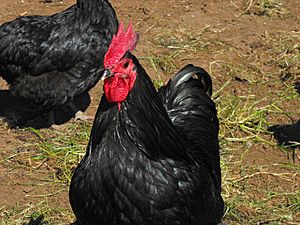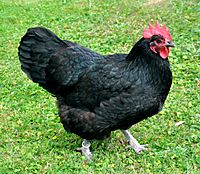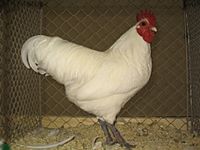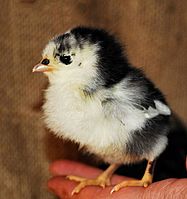Australorp facts for kids
The Australorp is a special type of chicken that comes from Australia. It was first created to be a great egg-laying chicken, and it's super famous for laying more than 300 eggs a year!
This breed became popular all over the world in the 1920s. That's when some Australorp hens broke amazing world records for how many eggs they could lay. Since then, they've been a favorite chicken breed in many Western countries. The Australorp is one of eight chicken breeds that were first developed in Australia.
The most common color for Australorps is black. In the United States, only black Australorps are officially recognized. But in Australia, you can also find blue and white Australorps. In South Africa, they even recognize colors like buff, splash, wheaten laced, and golden!
Contents
History of the Australorp
The Australorp chicken started its journey in Australia. It was developed from chickens brought over from England around the late 1800s and early 1900s. These original chickens were mostly Black Orpingtons.
Australian chicken breeders worked hard to make these chickens even better at laying eggs. They mixed in a little bit of other breeds like Minorca, White Leghorn, and Langshan. Some people even say a little Plymouth Rock blood was used too! The main goal was to create a chicken that was really good for farming. At first, these new chickens were called "Australian Black Orpingtons."
How the Name "Australorp" Came About
The name "Australorp" has an interesting story! One person, William Wallace Scott, might have suggested the name before World War I. Later, in 1925, he worked to get "Australorp" recognized as a proper breed name.
Another person, Arthur Harwood, suggested in 1919 that the "Australian Laying Orpingtons" should be called "Australs." He then thought of adding "orp" to the end to show that the breed came mostly from Orpingtons.
The name "Australorp" became widely used in the early 1920s when these chickens started to be known around the world. In 1929, the Australorp was officially added to the "Standard of Perfection," which is like a rulebook for chicken breeds.
Australorp Characteristics
Australorps come in two main sizes:
- Standard size: These are the larger chickens.
- Bantam size: These are much smaller, like miniature versions.
The Australian Poultry Standard officially recognizes three colors for Australorps: black, white, and blue. White Australorps have been around since 1949, but they were only officially recognized in 2011. The black Australorps often have beautiful feathers that shine with a dark green color in the light!
The Poultry Club South Africa recognizes even more colors. They include buff, splash, wheaten laced, and golden Australorps.
Amazing Egg Laying
The Australorp chickens became famous worldwide because of their incredible egg-laying abilities!
In 1922–1923, a team of six Australorp hens set a world record. They laid a total of 1857 eggs in one year! That means each hen laid an average of almost 310 eggs. This was super impressive because they did it without any special lighting that modern farms use today.
Because of these amazing results, people from England, the United States, South Africa, Canada, and Mexico rushed to import Australorps.
Well-cared-for Australorps can lay about 250 light-brown eggs each year. One Australorp hen even set a new record by laying 364 eggs in 365 days!
Australorps are also known to be good mothers. They like to sit on their nests and take care of their chicks. This makes them one of the most popular large chicken breeds for both eggs and meat.





